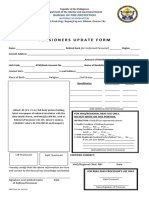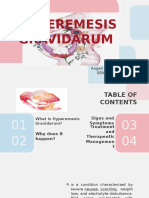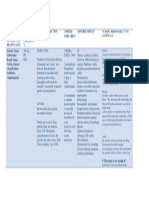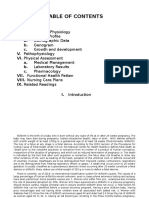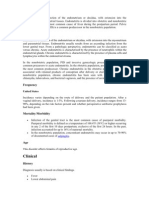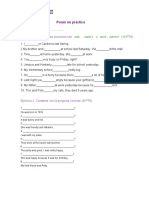Uterine Atony
Uterine Atony
Uploaded by
Arsheina ParadjiCopyright:
Available Formats
Uterine Atony
Uterine Atony
Uploaded by
Arsheina ParadjiCopyright
Available Formats
Share this document
Did you find this document useful?
Is this content inappropriate?
Copyright:
Available Formats
Uterine Atony
Uterine Atony
Uploaded by
Arsheina ParadjiCopyright:
Available Formats
PROVIDING AND MANAGING AN UTERINE ATONY AFTER DELIVERY Uterine Atony - one of the causes of postpartal hemorrhage.
Relaxation of the uterus.
Factors to uterine atony: 1. Grand multiparity. 2. Advanced maternal age 3. Overdistension of the uterus - The uterus can become 'over stretched or over-distended' in a sense, leading to an increased chance of it being less able to contract adequately enough to control the bleeding after the baby is born. Includes the following: Multiple pregnancy Polyhydramnios: greater than 1,500 ml Diabetic mellitus complicating pregnancy: large babies or macrosomia 4. Dysfunctional labor: Precipitate (rapid) - Occasionally a fast labour and birth can be followed by a primary postpartum haemorrhage. It is as if the uterus has worked very hard for a short period of time then decided to 'stop work', not contracting adequately after the birth Dystocia (prolonged) labor - If the labour is unusually prolonged the uterus can 'tire' and not contract efficiently after the birth. 5. Oxytocin stimulation or augmentation during labor 6. General inhalation anesthesia which produces uterine relaxation 7. Placental complications: Placenta previa - . With a placenta previa the thin, lower segment of the uterus (where the placenta is attached) is less efficient at contracting, compared with the thick, upper segment of the uterus, increasing the chances of a postpartum haemorrhage. Abruption placenta - can cause bleeding into the uterine muscles, decreasing the muscles ability to contract efficiently after the baby is born, in some cases leading to a PPH. 8. Mismanagement of the third stage of labor 9. Use of tocolytic that relax uterine muscles 10. Previous postpartal hemorrhage - If the woman has experienced a primary postpartum haemorrhage with a previous birth, then she has an increased chance of experiencing one with a subsequent birth (but it does not necessarily mean that she will definitely haemorrhage again). 11. Unknown cause Signs and Symptoms: 1. Uterine fundus is soft, boggy or non- palpable 2. Vaginal bleeding 3. Pallor 1
4. Tachycardia 5. Absence of any laceration 6. Complete placenta Managing Uterine Atony: A. Call a doctor/ refer Uterine Atony is a serious complication after delivery, a nurse, a midwife, or traditional birth attendant should refer clients with complications of labor and delivery. B. Stay Do not leave a mother with soft fundus. She can hemorrhage to death. C. Rub up a contraction by massaging fundus express any clots. D. Oxytocics (Pitocin, methergine or ergotrate) and IV fluids may be given. E. Dont pack the uterus packing the uterus dilates it, thus concealing further bleeding. F. Employ bimanual compression and massage consist of a gloved abdominal hand to massage the fundus of the uterus or posterior aspect of the uterus with the other (the gloved and fisted) hand inserted through the vagina to pressed against the uterus and massage the anterior aspect of the uterus with the hands knuckles in contact with the uterine wall. G. Keep all pads and linens to assess the volume of blood loss. H. Remain calm and continue to support the mother until she regains feeling of confidence and security. I. If the condition happens in the home, transport the client to the nearest hospital. Position the woman flat with legs elevated in modified trendelenburg position Keep warm with blanket Reassure the client to keep her calm Monitor blood loss, pulse and respiration The most important endeavor to keep uterus firm and contracted: Additional measures: A. Offer a bedpan or assist the ambulating woman to the bathroom at least every 4 hours to keep bladder empty. A full bladder pushes an uncontracted uterus into an even more uncontrated state. To reduce bladder pressure, insertion of a urinary catheter may be ordered. Encourage the mother to stimulate her nipple to enhance oxytocin release by posterior pituitary gland Place an ice cap over the fundus.
B. If the woman is experiencing respiratory distress from decreasing blood volume, administer oxygen by face mask at a rate of 4L/min Position her supine to allow adequate blood flow to the brain and kidneys.
C. Obtain vital signs frequently and make sure to interpret them accurately, looking for trends. Ex. Continuously rising pulse rate is an ominous pattern.
If a woman is losing enough blood to affect her systematic circulation, she will develop signs of shock: Increased, thread and weak pulse 2
Decreased blood pressure Increased and shallow respirations Pale Clammy skin Increasing anxiety References: http://www.birth.com.au/Postpartum-haemorrhage-(PPH)/Causes-of-a-PPH.aspx?view=full Rosalinda Parado Salustiano, RN, RM, MAN, PhD.,Dr. RPS Essential Procedures for Safe Maternity Care., Second Edition. Page 311-314 Adele Pillitteri.,Maternal & Child Health Nursing: Care of the Childbearing & Childrearing Family.,Vol. 1, 5th Edition. Page 656-659
You might also like
- Penawaran Maintenance Genset PT - Wilka PowerDocument1 pagePenawaran Maintenance Genset PT - Wilka Powerrifki100% (3)
- Nursing Care Plan For Different Age GroupsDocument8 pagesNursing Care Plan For Different Age GroupsBrenden Justin NarcisoNo ratings yet
- Uterine AtonyDocument2 pagesUterine AtonyBryan Relado AmbitoNo ratings yet
- Teaching Plan On Newborn ScreeningDocument8 pagesTeaching Plan On Newborn ScreeningQueenie Sicco100% (1)
- Anemia Unspecified FinalDocument47 pagesAnemia Unspecified FinalMaria Paula BungayNo ratings yet
- UMAT ExampleDocument9 pagesUMAT ExampleAnonymous WAgzcf9No ratings yet
- Viernes, Jemalyn BSN 2-3 Assessment Diagnosis Planning Implementation Rationale EvaluationDocument8 pagesViernes, Jemalyn BSN 2-3 Assessment Diagnosis Planning Implementation Rationale EvaluationJeMalyn VieRnesNo ratings yet
- Uterine AtonyDocument33 pagesUterine AtonyNonie 'Erni' HastiriniNo ratings yet
- NSVDDocument48 pagesNSVDchiqui14100% (2)
- NURSING CARE PLAN Interrupted Breastfeeding: Student Nurses' CommunityDocument3 pagesNURSING CARE PLAN Interrupted Breastfeeding: Student Nurses' CommunitySaira SucgangNo ratings yet
- Typology Family Nursing Care PlanDocument9 pagesTypology Family Nursing Care PlanteuuuuNo ratings yet
- Now, Try Some Big Leap.: Keep GoingDocument10 pagesNow, Try Some Big Leap.: Keep GoingCameron De GuzmanNo ratings yet
- Post-Term Labor - NCPDocument7 pagesPost-Term Labor - NCPCameron De GuzmanNo ratings yet
- Difference Between Physiologic Jaundice and Pathologic JaundiceDocument2 pagesDifference Between Physiologic Jaundice and Pathologic JaundiceNurulAqilahZulkifli100% (4)
- Cord ProlapseDocument3 pagesCord ProlapseEka Cyril67% (3)
- NCP PihDocument8 pagesNCP PihReinell GoNo ratings yet
- Delivery Nursing Care PlanDocument6 pagesDelivery Nursing Care PlanKayelyn-Rose CombateNo ratings yet
- Plasenta PreviaDocument4 pagesPlasenta PreviaZattira PutriNo ratings yet
- Powerpoint Case Study of MiscarriageDocument25 pagesPowerpoint Case Study of MiscarriageAngel CauilanNo ratings yet
- NCP Proper 1Document6 pagesNCP Proper 1Noreen PinedaNo ratings yet
- Premature Rupture of MembranesDocument3 pagesPremature Rupture of MembranesSheena Kunkel100% (2)
- Beta ThalaDocument2 pagesBeta ThalaAngie LamoNo ratings yet
- Incomplete Abortion: A Mini Case Study OnDocument22 pagesIncomplete Abortion: A Mini Case Study OnSunny MujmuleNo ratings yet
- Health Teaching PlanDocument10 pagesHealth Teaching PlanPaolo Vittorio Perdigueros GonzalesNo ratings yet
- Introduction HmoleDocument32 pagesIntroduction HmoleBrian Montales BaggayanNo ratings yet
- RLE 109 Group 4 Case Analysis in MastitisDocument20 pagesRLE 109 Group 4 Case Analysis in MastitisEugene MananganNo ratings yet
- UPDATE FORM PensionersDocument2 pagesUPDATE FORM PensionersMahaplag FS BfpNo ratings yet
- Pregnancy Induced HypertensionDocument25 pagesPregnancy Induced HypertensionPauPauNo ratings yet
- BSN 2F - Drug StudyDocument5 pagesBSN 2F - Drug Study22 - Fernandez, Lyza Mae D.No ratings yet
- Hyperemesis GravidarumDocument54 pagesHyperemesis GravidarumAngeli Luz BonaobraNo ratings yet
- NCP Drug Study Group 1Document21 pagesNCP Drug Study Group 1Cassandra Grace Muerong Dela CruzNo ratings yet
- CefuroximeDocument1 pageCefuroximeRox SanNo ratings yet
- Cardinal Movements of LaborDocument2 pagesCardinal Movements of LaborAimhigh_PPM100% (1)
- Individual Activity 3 PDFDocument11 pagesIndividual Activity 3 PDFBanana QNo ratings yet
- StillbirthDocument27 pagesStillbirthJoseph Nawen SindiongNo ratings yet
- HMOLEDocument34 pagesHMOLEZuellen Mae Garapan BedañoNo ratings yet
- Group-5 NCM-107 NCPDocument4 pagesGroup-5 NCM-107 NCPbulok netflakes100% (1)
- CASE STUDY Acute Pain Related To Laceration 1Document29 pagesCASE STUDY Acute Pain Related To Laceration 1Maria Jessica Dumdum100% (1)
- Roxipan (Oxytocin) - Drug StudyDocument4 pagesRoxipan (Oxytocin) - Drug StudyIzza DeloriaNo ratings yet
- 4 Flow Chart PretermDocument4 pages4 Flow Chart PretermYeni PuspitaNo ratings yet
- NCP Episiotomy WoundDocument3 pagesNCP Episiotomy WoundJP2001No ratings yet
- Nursing Care Plan Pneumonia With Congenital Heart DiseaseDocument18 pagesNursing Care Plan Pneumonia With Congenital Heart DiseaseKarri Ann Tonel100% (2)
- Abortion BSN 0PR-2: Case Study of BelleDocument27 pagesAbortion BSN 0PR-2: Case Study of BellekervinNo ratings yet
- Abhay ArabDocument2 pagesAbhay ArabPrabin PaulNo ratings yet
- CATAINA, Maria Elizabeth D. - Case-scenario-DRDocument3 pagesCATAINA, Maria Elizabeth D. - Case-scenario-DRMarielle CatainaNo ratings yet
- Assessment Nursing Diagnosis Rationale Expected Outcome Nursing Interventions Rationale EvaluationDocument1 pageAssessment Nursing Diagnosis Rationale Expected Outcome Nursing Interventions Rationale EvaluationMark Fernandez100% (1)
- Cesarean Section Report Richard LimDocument48 pagesCesarean Section Report Richard LimEj Pogi100% (1)
- Pregnancy Induced Hypertension (PIH)Document3 pagesPregnancy Induced Hypertension (PIH)Susan HepziNo ratings yet
- Nursing Care Plan For Interrupted Breastfeeding NCPDocument3 pagesNursing Care Plan For Interrupted Breastfeeding NCPSaira SucgangNo ratings yet
- Case StudyDocument19 pagesCase Studywella goNo ratings yet
- Ob Topic 1 - Pprom - NCPDocument2 pagesOb Topic 1 - Pprom - NCPThelly MargalloNo ratings yet
- EndometritisDocument6 pagesEndometritisandriansyah2110% (1)
- A Case Presentation On Pregnancy Induced HypertensionDocument7 pagesA Case Presentation On Pregnancy Induced Hypertensionzygote_23100% (1)
- Trends in The Maternal and Child Health Nursing PopulationDocument1 pageTrends in The Maternal and Child Health Nursing PopulationAnnalisa TellesNo ratings yet
- CASE STUDY: Pre Labor Infant With Respiratory Distress SyndromeDocument4 pagesCASE STUDY: Pre Labor Infant With Respiratory Distress SyndromeE.R.O100% (1)
- Pregnacy Induced Hypertension PhysiologyDocument1 pagePregnacy Induced Hypertension PhysiologyCyrus De AsisNo ratings yet
- Pre Eclampsia Case StudyDocument39 pagesPre Eclampsia Case StudyAnton RossiniNo ratings yet
- Nursing Care Plan For Knowledge DeficitDocument3 pagesNursing Care Plan For Knowledge DeficitRegine BautistaNo ratings yet
- Abruptio Placentae: ALCANTARA, Eduardo L. Ms. Analinda R. Sese, RN, MANDocument45 pagesAbruptio Placentae: ALCANTARA, Eduardo L. Ms. Analinda R. Sese, RN, MANinscenekivir100% (1)
- Ventricular Septal Defect, A Simple Guide To The Condition, Treatment And Related ConditionsFrom EverandVentricular Septal Defect, A Simple Guide To The Condition, Treatment And Related ConditionsNo ratings yet
- The Ride of Your Life: What I Learned about God, Love, and Adventure by Teaching My Son to Ride a BikeFrom EverandThe Ride of Your Life: What I Learned about God, Love, and Adventure by Teaching My Son to Ride a BikeRating: 4.5 out of 5 stars4.5/5 (2)
- Bab Gec 3101 Midterm Module 1Document46 pagesBab Gec 3101 Midterm Module 1Marc Oliver NabablitNo ratings yet
- Using Excel'S Rand FunctionDocument239 pagesUsing Excel'S Rand FunctionSyed Ameer Ali ShahNo ratings yet
- Mike Mukamwe Project Year 2Document68 pagesMike Mukamwe Project Year 2Mukamwe MikeNo ratings yet
- MuNu Brochure Product PossibilitiesDocument5 pagesMuNu Brochure Product PossibilitiesIman AkbariNo ratings yet
- SpirotechDocument2 pagesSpirotechBimalesh MishraNo ratings yet
- Download Complete Green Photocatalysts Mu. Naushad PDF for All ChaptersDocument65 pagesDownload Complete Green Photocatalysts Mu. Naushad PDF for All Chaptersmechewrinnir100% (1)
- Case Study (1) Answer All Questions Renal Function AssessmentDocument5 pagesCase Study (1) Answer All Questions Renal Function AssessmentMoneebNo ratings yet
- Khamira Gaozaban AmberiDocument104 pagesKhamira Gaozaban AmberiShariq NoorNo ratings yet
- Global Iron Ore DataDocument4 pagesGlobal Iron Ore DatabogdanberchiNo ratings yet
- Electromagnetic Signals: Engr. Mark Jefferson A. Arellano, Ect, VCP, RtaDocument52 pagesElectromagnetic Signals: Engr. Mark Jefferson A. Arellano, Ect, VCP, RtaMark ArrelanoNo ratings yet
- Mayuresh StotraDocument4 pagesMayuresh StotraPawan MadanNo ratings yet
- Instant Download Pharmacogenomics and Personalized Medicine Methods in Pharmacology and Toxicology Methods in Pharmacology and Toxicology 1st Edition Nadine Cohen PDF All ChaptersDocument50 pagesInstant Download Pharmacogenomics and Personalized Medicine Methods in Pharmacology and Toxicology Methods in Pharmacology and Toxicology 1st Edition Nadine Cohen PDF All Chaptershijarrazan1e100% (13)
- 00-V005 Document Control Procedure Rev 180311Document21 pages00-V005 Document Control Procedure Rev 180311Tuong NguyenNo ratings yet
- PH10 PLUS Installation and User's GuideDocument51 pagesPH10 PLUS Installation and User's GuideCesar de la LuzNo ratings yet
- Harmonies of Tones and Colours Developed by Evolution by F J Hughes, 1883Document105 pagesHarmonies of Tones and Colours Developed by Evolution by F J Hughes, 1883popmolecule100% (9)
- Mucogingival Conditions in The Natural DentitionDocument10 pagesMucogingival Conditions in The Natural DentitionMartty BaNo ratings yet
- Varied Modal Verbs Exercises II PDFDocument10 pagesVaried Modal Verbs Exercises II PDFFrancisco Cañada Lopez100% (1)
- K385WHI RCD Connection Unit Tech FINALDocument1 pageK385WHI RCD Connection Unit Tech FINALbrightstardustNo ratings yet
- List of Program For Practical File With Source CodeDocument19 pagesList of Program For Practical File With Source CodeWilly WonkaNo ratings yet
- Design and Development of Tube-Launched Unmanned Aerial VehicleDocument5 pagesDesign and Development of Tube-Launched Unmanned Aerial VehiclebeshirNo ratings yet
- JEE THEORY Magnetic Effect of Current and MagnetismDocument19 pagesJEE THEORY Magnetic Effect of Current and Magnetismepicqueen080No ratings yet
- 05 - Steam DistillationDocument10 pages05 - Steam DistillationHuỳnh TẤn PhátNo ratings yet
- Pok俶on ROWE - Wild Encounter TablesDocument122 pagesPok俶on ROWE - Wild Encounter TablesKhamaleonNo ratings yet
- Vajrasekhara Sutra Vajradhatu Great Bodhimanda Mahavairochana Tathagata Personal Enjoyment Body Inner Realization Wisdom Followers ofDocument7 pagesVajrasekhara Sutra Vajradhatu Great Bodhimanda Mahavairochana Tathagata Personal Enjoyment Body Inner Realization Wisdom Followers ofWilliam D. Jackson IIINo ratings yet
- Focus SE 2013 2.0LDocument419 pagesFocus SE 2013 2.0LRoberto Carlos Cardenas QuirozNo ratings yet
- Tripcevich & Vaughn Eds Mining and Quarrying in The Ancient AndesDocument359 pagesTripcevich & Vaughn Eds Mining and Quarrying in The Ancient Andesjhonny zeballosNo ratings yet
- Articulo Duffy 2006Document18 pagesArticulo Duffy 2006esfNo ratings yet
- Poner en Práctica: Ejercicio 1. Completa Las Oraciones Con oDocument2 pagesPoner en Práctica: Ejercicio 1. Completa Las Oraciones Con oVidal Benavides LinaresNo ratings yet


























